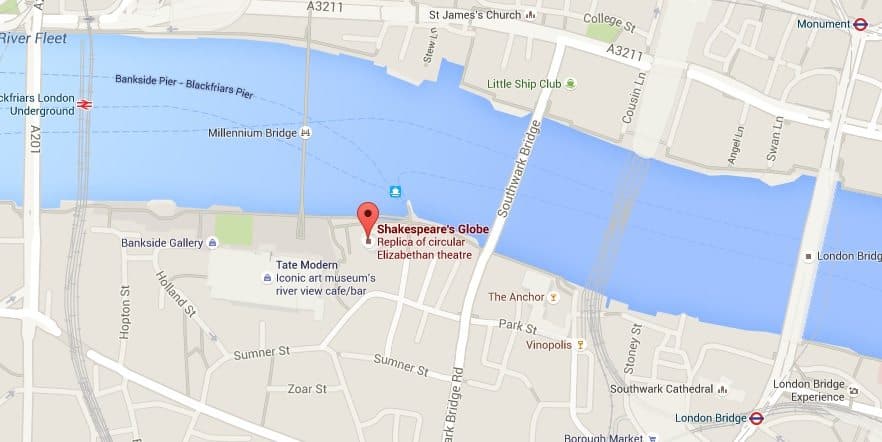This post is an overview of Shakespeare’s Globe Theatre, including how to take a tour and see a live show.
As a local tour guide and resident of London, I’ve had the pleasure of seeing quite a few shows over the years at this historic theatre.
Below I share with you information to help you have a great experience there.
Also, I’ve included the thoughts of some of the more than 165,000 members of our London Travel Tips Facebook group.
The group is made up of locals (like our tour guides), frequent travelers to the UK, as well as first-time visitors to London.
You don't need to join to read the posts, comments, and recommendations. So, check out our group once you've finished reading this post.
- Overview
- Take a Tour
- See a Show
- Tips from Locals and Travellers
- William Shakespeare's London Walking Tour
- London Theatre Tour
OVERVIEW
Perhaps one of the most famous theatres in the entire United Kingdom, the Globe Theatre is best known as home to William Shakespeare’s playing company.
Although the original Globe Theatre was lost to fire, today a modern version sits on the south bank of the River Thames.
Shakespeare’s Globe Theatre is now a huge complex holding a reconstructed original outdoor theatre, a winter theatre, a museum, and an education centre.
In the following sections, we go over Globe Theatre tours and directions there.
We will also cover details about how to see a show there.
TIP: Tours of the Globe are included with both the London Pass and the Explorer Pass.
You can also save money on tickets with the London City Pass.
Where is Shakespeare's Globe Theatre
The original Globe Theatre was built in 1599 and stood very near the location of the modern-day version.
Read an in-depth history at the end of this post.
The site of the original was not certainly known until 1989 when the foundations were discovered in a car park.
However, the foundations lie underneath a listed building, so no excavations can take place.
A plaque and information panel are in place near 67-70 Anchor Terrace on Park Street to commemorate this original location.

The modern-day theatre is located on the south bank of the River Thames.
Directions there:
The nearest London Underground Station is London Bridge (Northern and Jubilee lines), but you can also access it by walking over the Millennium Bridge from St. Paul’s Cathedral.
We recommend using this link for directions to Shakespeare’s Globe Theatre from anywhere in the London region.
TOURS OF SHAKESPEARE'S GLOBE THEATRE
Whether or not you plan to see a show, you can still get a good look inside Shakespeare’s Globe Theatre by taking a tour.
In the first 50 minutes of the tour, you will be led through the venue by a talented expert guide who will discuss the history of the theatre and what London was like when the Globe became famous.
Next, you will have 50 minutes of interactive experiences including access to past exhibitions, the chance to try on original stage costumes in the exhibition and see some of the production teams at work.
This tour is offered all year long, so you can take it just about any time regardless of the weather.
Keep in mind that it is an open-air theatre, so the weather might play a role in your enjoyment of the experience.
- Tickets: £26 Adults | £19 Children under 16 years of age
- Availability: Daily (except for holidays)
- Schedule: 10 am - 5 pm, every 15 minutes. Fall/Winter months have shorter hours.
- Duration: 2 hours
- Purchase tickets in advance and learn more.
If you can’t manage to secure tickets until the day of your trip, you can walk up to the box office and ask about any available tour spots.
Chances are that they will be able to accommodate you.
TIP: If you are considering buying one of the money-saving tourist attraction passes, such as the London City Pass, London Pass, or Explorer Pass, a Globe Theatre tour is included.
Alternatively, you can also use Discount London to get your tickets for less.
If you want to learn about the Globe Theatre and Shakespeare himself, join us for our pay-what-you-wish William Shakespeare's London Walking Tour!
SEE A SHOW AT SHAKESPEARE'S GLOBE THEATRE
No matter how old this venue gets, it’s still one of the best places in London to enjoy a theatrical performance.
The Globe Theatre is an open-air playhouse, so most shows will take place between April and October.
At the start of each theatre season, a new schedule will be posted on their site.
You can learn more about the next available show by visiting their What’s On page.
Although the guided tour is available throughout the year, other performances and activities will only be offered for a short time.
There are only 857 seats, so seated tickets can be difficult to obtain and expensive (from £25-£75).
Thankfully, there are 700 standing-room tickets available for each show and they only cost either £5 or £10 so this doesn’t have to be an expensive activity.
We highly recommend purchasing tickets well ahead of time to avoid missing out.
TIPS FROM LOCALS AND TRAVELLERS
Here are some tips and opinions from members of our London Travel Tips and Hacks Facebook group on both the tour and the performances.
Reviews of the tour were overwhelmingly positive. All age groups got something out of it.

Here’s a group member who has taken the tour twice and seen shows. It was a hit activity with the whole family.

The member has been lucky enough to do the tour and see more than one show.

Here’s what group members thought of the performances.

If you do see a show, here is some advice on how to prepare…

…and how once the show begins, you won't notice anything else but!

HISTORY OF SHAKESPEARE'S GLOBE THEATRE
The Globe was constructed in 1599 and the first production here was likely either Henry V or Julius Caesar although no firm record exists.
The theatre was owned by several Shareholders – and Shakespeare himself was just one of the people in this group.
It is estimated that Shakespeare’s ownership in the Globe eventually diminished to just 7% throughout his career.

Although today we heavily associate The Globe with Shakespeare, many other playwrights had work performed at this theatre.
The first recorded performance of a play at the Globe Theatre was not a Shakespeare play at all, but Every Man Out of His Humour by Johnson.
Layout
Although the exact dimensions of the original theatre are not known, the structure and design of the building have been researched heavily throughout the centuries.
Primary sources leave enough information that the construction of the Globe can be accurately estimated.
The Globe was a three-story open-air amphitheater with a diameter of around 100ft (30m) and could hold upwards of 3,000 spectators.

Although imagined as a circular shape (a “wooden O” as referenced in Shakespeare’s Play Henry V), the theatre was likely a polygon of around 20 sides.
The base of the stage held a yard where – for a single penny – spectators could buy a ticket to become a ‘groundling’ who would stand on the dirt floor throughout the performance.
This yard was surrounded by three levels of stadium-style seats, a more luxurious option for wealthier patrons.
Above the stage was a filing known as the “heavens” which was painted like the sky with clouds and stars.
The heavens contained a trap door with which actors could descend and ascend when required.
A trap door built into the stage also allowed for the movement of actors on and off the stage.
Destruction
During a performance of Henry VIII on the 29th of June 1613, a fire sparked by the firing of a theatrical cannon lit the wooden beams and thatching the theatre alight.
Although the theatre was destroyed, nobody was injured in the tragic event (aside from a single man whose breeches were on fire, but the flames were put out with a bottle of ale).
Modern Recreation
In 1970, American actor and director Sam Wanamaker founded the Shakespeare Globe Trust and the International Shakespeare Globe Centre.
The idea was a faithful recreation of Shakespeare’s Globe should be built near its original position on the banks of the river.
No easy task, Wanamaker fought detractors who believed a faithful reconstruction would not be possible.
Many insisted that the new building would be a fire hazard, and others said the recreation would not be a viable tourist attraction.
Despite the criticism, Wanamaker persevered and (with minor exceptions such as external staircases and fire sprinklers) a faithful reconstruction of Shakespeare’s Globe Theatre was eventually designed and built, using the same materials as the original.
Shakespeare’s Globe Theatre was then opened to the public in 1997 – 4 years after Wanamaker died.
Performances here are staged to duplicate the original environment of the Globe. This means there are no spotlights, and where possible plays are staged in the daylight.
There are also no microphones or speakers of any sort. All music accompaniment is performed live and the proximity of the actors to the spectators makes performances appear more accessible and intimate.
Although the outlay is the same, the seating capacity in the modern Globe is 857 with 700 more standing – giving it around half the capacity of the original Theatre.
Built of English Oak like the original, Shakespeare’s Globe Theatre was constructed with absolutely no structural steel.
The thatched roof of the New Globe was a subject of much debate as roof thatching had been outlawed after the Great Fire of London in 1666.
Wanamaker fought long and hard to utilize the thatch and this is the first – and only – permitted thatched roof in London since 1666!
While not an exact reconstruction of an original building, the Sam Wanamaker Playhouse loosely resembles the nearby Blackfriars Theatre which had been built in 1566.
Today
Today, Shakespeare’s Globe Theatre stands around 230m (750ft) from the original Globe site.
The design of the theatre is the same as the original with a stage surrounded by a circular yard (where ‘groundlings’ can still view performances!) and three tiers of raked seating.
Because the theatre is circular, there is no roof over the centre of the structure, so plays are only staged during the summer.
Originally, women were not allowed on stage, and during Shakespeare’s lifetime, it would have been only men who performed his work.
Occasionally the Globe harkens back to this era, putting on entire performances where all roles are played by men.
However, both genders are on stage regularly throughout the seasons.
In addition to the recreated Globe Theatre, Shakespeare’s Globe’s Trust now also houses the Sam Wanamaker Playhouse – a 17th-century style indoor theatre.
Much like Shakespeare’s Globe, the Sam Wanamaker Playhouse was built using period-accurate materials and building styles, and similarly, as well, the Playhouse uses beeswax candles to light the stage rather than modern-day lighting fixtures.
The Playhouse houses around 340 seats and hosts productions throughout the winter and spring months.









